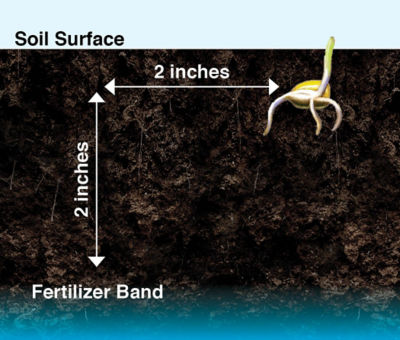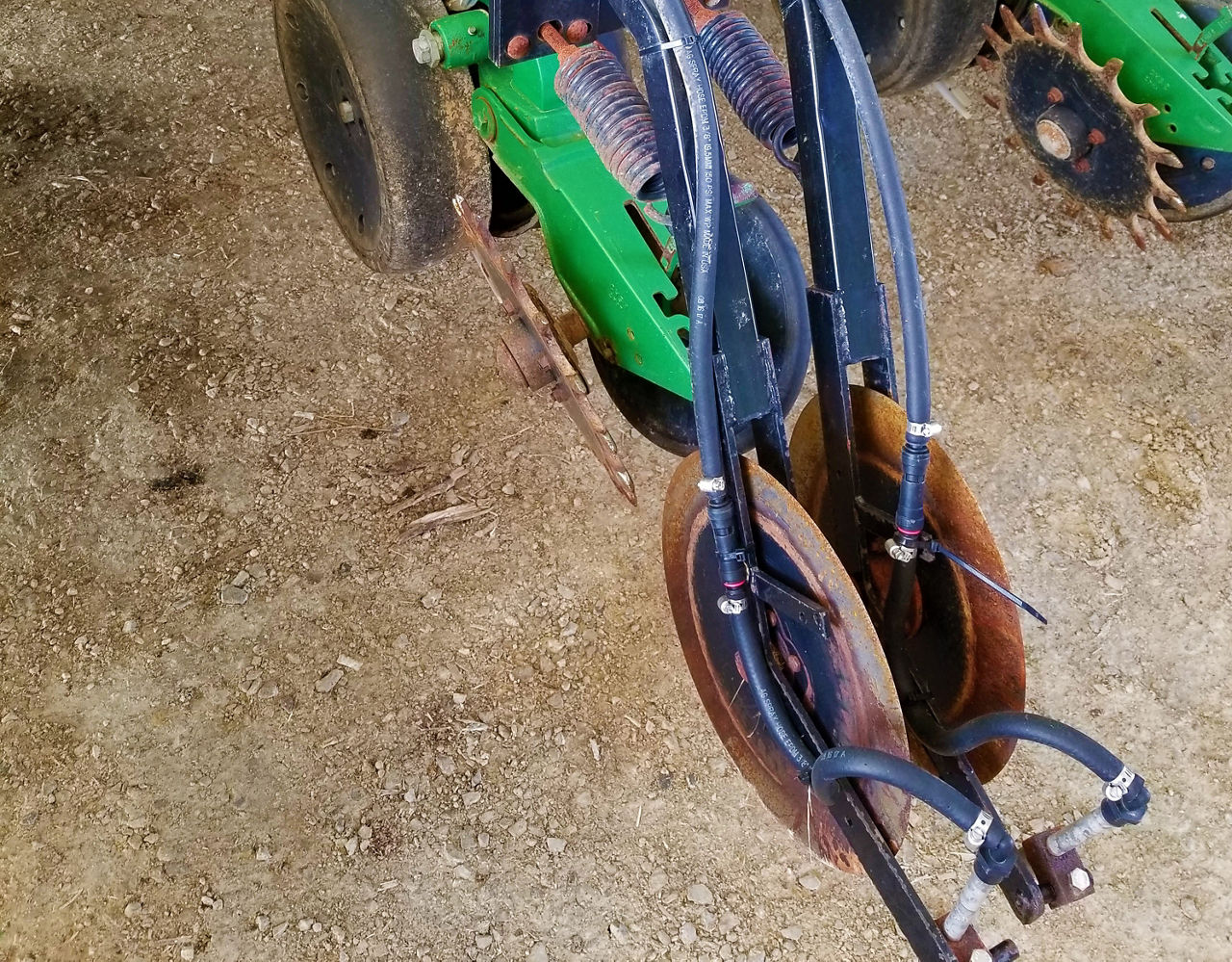7 MIN READ
Application of Starter Fertilizers in Corn
November 3, 2021
Placing small amounts of key nutrients in starter fertilizers may increase corn yield potential.
Starter fertilizer can help meet the early demands of seedlings until the development of plant nodal root system.
Fields with cool soil temperatures, low phosphorus (P) levels, soils low in organic matter, and high pH soils are more likely to show a positive response to starter fertilizer applications.
Benefits
Farmers typically use starter fertilizer products that contain combinations of key plant nutrients such as nitrogen (N), phosphorus (P), potassium (K)], and sulfur (S) to improve corn early-season uptake, nutrient use efficiency, and crop growth under cool and moist soil conditions. Starter fertilizer can also increase early-season corn growth and plant height, decrease time to silk, and reduce grain moisture content. However, corn grain yield increases from starter fertilizer application can vary across production systems and growing conditions.
Key Nutrients
The macronutrients used in large amount by corn plants are N, P, and K. Generally, a starter fertilizer is used to supply N and possibly P. The addition of other nutrients should be based on the response of a corn product to starter fertilizers and soil nutrient needs driven by a soil test recommendation.
Nitrogen is the most limiting element in corn production and can be a beneficial part of starter fertilizer. Nitrogen is highly mobile in soil, especially under high precipitation conditions, and can be easily leached if N availability is not synchronized with crop uptake. Applying N as part of a starter fertilizer program in addition to splitting applications during crop growth can help decrease potential for leaching and denitrification in the soil.
Phosphorus. Phosphorus is another macronutrient found in starter fertilizers. Phosphorus can have limited movement within the soil profile, which may lead to deficiency symptoms. This makes the close proximity of starter fertilizer to the seed ideal for P applications. Starter P is especially important in soils with low P levels; however, soils with high levels of P have also shown a response to starter fertilizers.1,2 Research has shown that response to starter fertilizer application was more consistent for N alone than for P alone, but the combination of N and P was generally the most desirable option.
Potassium is also involved with early plant growth, but K is less common in starter fertilizers. Seedling nutrient requirements are relatively small for K, which reduces the need for K to be added in common starter fertilizer applications. However, soil K can be tied up in soil minerals and become unavailable to plants, which causes the amount of K supplied in soils to vary. Soil test results should be utilized to guide the use of K in a starter fertilizer.4
Other nutrients that can be used in a starter fertilizer include sulfur (S). Sulfur should be included at a rate high enough to sustain the corn crop through V5 in fields where S is low, particularly in low organic matter soils. In high yielding environment, corn may require 30 to 40 lb/acre of S. Some that can be applied as a starter and the remainder as a sidedress application3.
Starter Fertilizer Placement
The most common and recommended starter fertilizer placement is 2 inches to the side and 2 inches below the kernel at planting (2-by-2 band). Placed in this manner, the possibility of fertilizer injury to the seed is reduced (Figure 1). However, applying a 2-by-2 band may require additional investment to equip planters and a slower planting speed. These drawbacks, plus the availability of low-salt fertilizers, have led to an interest in furrow placed fertilizers. Direct placement of starter fertilizer with the seed, also known as in-furrow or pop-up placement, is practical and economical for growers with a corn or corn-cotton system because growers typically use in-furrow equipment for insecticide and fungicide applications. Since the seed has direct contact with the starter fertilizer, care must be taken to keep rates low enough to avoid fertilizer injury to the seed.

Products4
Solid and fluid forms of starter fertilizer exist and if applied at similar rates and placement, provide the same results. Liquid fertilizers can be applied at lower quantities than dry forms and the effect of the nutrients when they are applied at the same rate per acre is the same. While liquid forms are more expensive than dry materials, if applied accurately and at the lower quantity, they can be cost effective. An economical, high-quality, complete fertilizer containing N and P can work as a starter fertilizer. In general, a fertilizer with a high P ratio (1-2-1, 1-3-1, etc.) in a highly water-soluble form and combined with ammonium nitrogen can be used. If applying in-furrow, recommended rates are 4 to 5 gallons per acre. Formulations may change based on availability and if other nutrients are added. Monoammonium phosphate (MAP 11-52-0) based materials are good choices, and ammonium polyphosphate (APP 10- 34-0) is also a widely used liquid starter fertilizer. Starter fertilizers containing only N may be sufficient for soils regularly applied with livestock or poultry manure, as those soils may already contain high levels of P. Diammonium phosphate (DAP; 18-46-0) and especially products containing urea (46-0-0) may cause injury at higher rates and if placed close to the seed.
Soil Analysis
Soil testing is the best tool for growers to make fertilizer decisions. Samples can be taken any time after harvest, but should not be completed after a fertilizer, lime, or manure application. Samples should also be taken prior to tillage to increase sample reliability. Soil testing is recommended at least once every three years.5 However, annual testing is more accurate to help determine what nutrients should be applied and at what rates. The amount of N and/or P used as a starter fertilizer can be deducted from the total recommended nutrient requirement for the season.6
Key Learnings from a Meta-Analysis of Starter Fertilizer Application7
Responses of corn to starter fertilizer can vary across production systems and environments. A large meta-analysis of 474 studies conducted in the United States from 1990 to 2019 on starter fertilizer indicated the following7:
Across all 474 comparisons, grain yield was increased by 5.2% with a starter fertilizer application compared to corn without starter fertilizer. Of the 474 comparisons of corn with starter vs corn without starter, 74% of the fields had a yield increase from the starter application.
When N was not limiting, the impact of a 2 x 2 application (Figure 1) had similar results to in-furrow applications when most of the N was applied at planting or before. However, when the majority of N was applied as a sidedress application, the 2 x 2 application increased yield almost 9% compared to no starter or when the starter was applied in furrow.
Regardless of previous crop (corn, soybean, cotton, sorghum, or wheat) yield was higher with the use of a starter fertilizer. This was perhaps a result of most studies applying N either pre- or at planting. Additionally, many producers increase N applications at pre- or at planting when corn follows a non-legume crop (corn, cotton, wheat) as compared to a legume crop (soybean, alfalfa).
Surprisingly, of the previous studies included in the meta-analysis, the impact of starter fertilizer was the same in no-till and tilled systems. Soil temperatures can be lower in no-till systems at planting thus reducing the rate of nutrient mineralization. However, tillage related differences in soil conditions like soil moisture and temperature may not justify changes to fertilizer management. Keep in mind this result maybe a result of the studies included in the analysis and the impact for a particular field may be different.
Yield increases were similar when the starter contained N and P as compared to products containing K as well. As most starter products contain a combination of nutrients with the recent inclusion of S in many products, the response documented in this study, by using combinations, appears well justified.
The impact of starter on yield was similar across different levels of soil organic matter, texture and planting month soil temperature and moisture conditions. This is contrary to the current opinion that starter fertilizer is more beneficial in course soils with low organic matter and under cool and wet soil conditions.
The analysis showed that while the response to starter fertilizer decreased when P and K were above recommended levels, a positive yield response was still found for both P and K when both were above the critical level. This suggests that starter fertilizer containing P and K may improve corn yield even when soil tests would not warrant it. A study in Ontario, Canada supported the finding of the mega-analysis, that a starter fertilizer increased yield both when P and K were both below and above recommended levels.1
At higher seeding rates, the benefit of starter fertilizer was limited when compared to a broadcast application. The researchers speculated that starter fertilizer may cause increased root growth thus increasing competition for available nutrients later in season.
As yield level increases, the benefit of starter fertilizer increases. The authors speculated that as yield potential increases, nutrient uptake also increases and reflects a greater crop demand and lowering risk of other limitations in the higher yield situation.

Summary
The response of corn to starter fertilizer applications is most likely a complex interaction of many variables that are field and environment specific. This will vary the result of a starter application across years and locations. While the meta-analysis supports the value of starter fertilizer in corn production, the result of any individual farm or field may vary and on-farm research may be beneficial in determining when and if a starter will increase profitability.
Sources
1 Bohner, H. 2018. Phosphorus and potassium management for corn, soybeans, and heat. Field Crop News. Ontario Ministry of Agriculture, Food and Rural Affairs. https://fieldcropnews.com/2017/03/phosphorus-and-potassium-management-for-corn-soybeans-and-wheat
2 Hergert, G.W., Wortmann, C.S., Ferguson, R.B., Shapiro, C.A. and Shaver, T.M. 2012. Using starter fertilizers for corn, grain sorghum, and soybeans. University of Nebraska-Lincoln. G361. http://ianrpubs.unl.edu.
3 Miller, J. 2018. Starter fertilizer for corn. University of Delaware Extension. https://sites.udel.edu/agronomy/2018/04/21/starter-fertilizer-for-corn/#:~:text=Sulfur%20should%20be%20included%20in,planting%20and%20again%20at%20sidedress.
4Ligenfelter, D. and Beegle, D. 1997. Starter fertilizer. Pennsylvania State University Extension. https://extension.psu.edu/starter-fertilizer
5 Davis, J.G., and Westfall, D.G. 2014. Fertilizing corn. Colorado State University Extension.
Fact Sheet No. 0.538. https://extension.colostate.edu/docs/pubs/crops/00538.pdf
6 Lee, D. 2019. A guide to corn production in Georgia 2019. The University of Georgia.
https://grains.caes.uga.edu/content/dam/caes-subsite/grains/docs/corn/2019-Corn-Production-Guide.pdf
7 Quinn, D., Lee, C., and Poffenbarger, H. 2020. Ten lessons from research about corn response to starter fertilization. Purdue University Extension. https://thekernel.info/cornyieldstarterfertilizer/
3009_S1